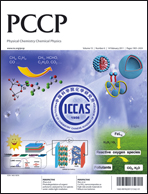Theoretical study of the infrared and Raman line shapes of liquid methanol†
Abstract
Using a combined electronic structure and molecular dynamics simulation method, we calculated the infrared and

- This article is part of the themed collection: ICCAS collection

 Please wait while we load your content...
Please wait while we load your content...